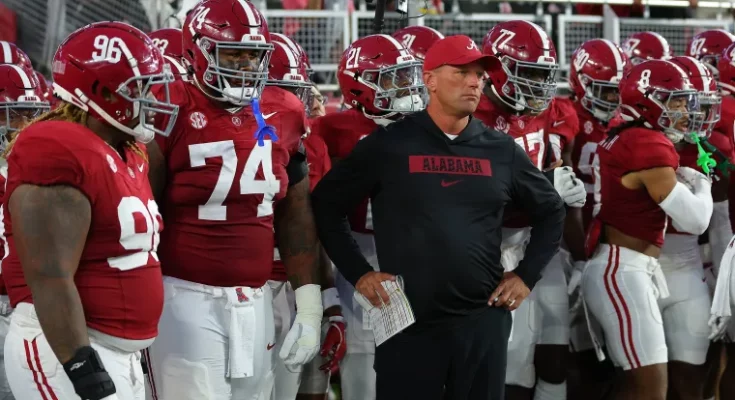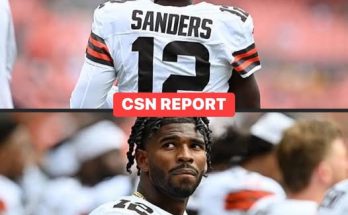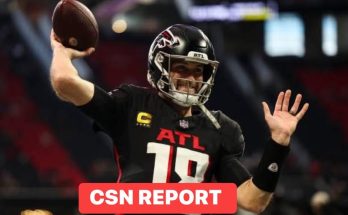BREAKING NEWS: Don’t Expect a Bounceback Year from the Alabama Crimson Tide
For nearly two decades, the Alabama Crimson Tide were synonymous with college football excellence. From national championships and Heisman Trophy winners to first-round draft picks and SEC dominance, the program built by Nick Saban established a gold standard that seemed untouchable. But as the 2025 season approaches, a sobering reality is setting in—this Alabama team may not bounce back the way fans, analysts, and college football traditionalists are hoping.
After a disappointing 2024 season in which Alabama missed the College Football Playoff for the second time in three years, expectations for a quick rebound were tempered. And now, with Saban officially retired and first-year head coach Kalen DeBoer still settling into the complexities of SEC life, the foundation of the Crimson Tide dynasty feels increasingly unsteady.
There are signs of promise, sure. DeBoer has infused the program with new energy and a fresh offensive philosophy. There’s a wave of young talent, including freshman phenom wide receiver Ryan Williams, who has already landed on the Maxwell Award watch list. But for every flicker of hope, there are deeper concerns—issues that suggest Alabama’s grip on college football supremacy may be slipping faster than many are willing to admit.
The first and most glaring challenge is the quarterback situation. After several years of elite quarterback play—from Tua Tagovailoa and Mac Jones to Bryce Young—Alabama enters 2025 with uncertainty under center. Jalen Milroe showed flashes in 2023, but his inconsistent passing and questionable decision-making led to a lack of continuity in the offense. While Milroe remains on the roster, his grasp on the starting role is anything but firm. Reports from spring practice indicated that sophomore Dylan Lonergan and true freshman Keelon Russell are both being given serious looks, but none of the candidates have shown they’re ready to lead a playoff-caliber offense.
That uncertainty bleeds into the broader offensive identity. Under DeBoer and new offensive coordinator Nick Sheridan, Alabama is shifting toward a more spread-oriented, pass-heavy scheme, a stark departure from the power-run system that defined the early Saban years or even the balanced attack seen under former OC Steve Sarkisian. While this could work in time, the personnel on the current roster isn’t built for this transition—at least not yet.
The offensive line, long a strength of the program, is in transition. Multiple starters from 2024 graduated or declared early for the NFL Draft, and while blue-chip recruits like Kadyn Proctor and Wilkin Formby have immense potential, they’re still developing. In the SEC, where defensive lines are fast, physical, and ruthless, inexperience on the offensive line can be catastrophic. Protecting a quarterback—whoever it ends up being—will be a weekly challenge.
Running back depth is another concern. In previous years, Alabama could rely on a stable of elite backs: Derrick Henry, Najee Harris, Brian Robinson Jr., and Jahmyr Gibbs. But the 2025 room is thinner than usual. Justice Haynes is expected to take on a heavier workload, but behind him are a collection of unproven backs. Without a dominant ground game to lean on, Alabama could find itself in the unfamiliar position of being one-dimensional—and that’s a dangerous place to be in this conference.
Defensively, the Crimson Tide face even more questions. Last season, under Kevin Steele, Alabama fielded a strong, though not elite, defensive unit. They were solid in coverage and stout in the red zone, but they struggled to create pressure against top-tier offenses. Now, Steele is gone, and in his place stands Kane Wommack, brought over by DeBoer to install a more aggressive, attacking style. While the scheme is intriguing, it demands discipline and coordination—two traits that may take time to develop in a defense full of turnover.
Key losses on defense include Dallas Turner and Kool-Aid McKinstry, both of whom left for the NFL and were cornerstones of the 2024 unit. Replacing that kind of talent doesn’t happen overnight, even at Alabama. Linebacker play is expected to be a liability early in the season, with communication breakdowns and missed assignments already a concern in early practices.
The secondary, always a point of pride in Tuscaloosa, is also in flux. Sophomore safety Caleb Downs transferred to Ohio State in one of the offseason’s most shocking portal moves, leaving a massive leadership and production void. While players like Jahlil Hurley and Antonio Kite are promising, they’ve yet to prove they can handle the weekly pressure of covering SEC receivers and diagnosing pre-snap reads.
Then there’s the matter of the SEC itself—arguably more competitive than it’s ever been. Georgia remains a juggernaut. LSU is a rising force under Brian Kelly. Texas and Oklahoma officially join the SEC this season, adding another layer of complexity to an already brutal conference slate. Even teams like Ole Miss and Tennessee have shown they can go toe-to-toe with Alabama in recent years. There are no easy weeks in the 2025 schedule. Every game will be a test.
And the early stretch of Alabama’s 2025 calendar is unforgiving: a Week 2 non-conference clash with Wisconsin, followed by road games at LSU and Georgia within the first six weeks. If the Tide stumble early, there won’t be time for a late-season surge. Momentum will be everything, and it’s unclear whether this team has the veteran leadership to withstand that kind of gauntlet.
Beyond the field, there’s also a cultural transition happening. The Saban era was built on process, discipline, and defensive dominance. It was run like a Fortune 500 company with one man calling the shots. Kalen DeBoer brings a different vibe—more player-friendly, more collaborative, more modern. While this could be a positive long-term, in the short-term it requires a reset. Veterans recruited by Saban are adjusting to a different style of leadership. Some embrace it; others remain skeptical.
The NIL landscape and transfer portal have only complicated this shift. Alabama, once a destination that recruited itself, now finds itself needing to compete harder in the NIL market than ever before. Other programs with flashier deals and fewer expectations are making serious inroads with top talent. And while Alabama still boasts a top-10 recruiting class, the days of locking down the No. 1 spot with ease appear to be over.
So, is Alabama still a good team? Absolutely. With this much talent and history, a losing season is almost impossible to imagine. But are they a great team? A playoff team? A national title contender?
That’s where the doubt creeps in.
The Crimson Tide enter the 2025 season in unfamiliar territory—not as a powerhouse expected to steamroll its way into the playoff, but as a program in flux, trying to rediscover its identity in a college football world that has changed dramatically in just a few short years.
There’s also a psychological factor at play. For years, Alabama didn’t just beat teams—they intimidated them. That aura is fading. Opponents no longer walk into Bryant-Denny Stadium in fear. Coaches and players speak openly about “closing the gap.” Some have already done it. For the first time in over a decade, Alabama looks beatable every Saturday.
There’s a saying in football: you’re either rebuilding or reloading. Under Saban, Alabama was always reloading. Under DeBoer, it’s beginning to feel like rebuilding.
And that’s okay—every dynasty eventually needs to reset. But for fans expecting an instant return to the heights of 2015, 2017, or 2020, this season might be a cold dose of reality. Patience is going to be required. So is perspective.
Because while the Crimson Tide might not bounce back in 2025, that doesn’t mean the dynasty is dead. It simply means it’s entering a new phase—one with different challenges, different leaders, and a different path forward.
Just don’t expect a championship banner this year.
Not yet.



